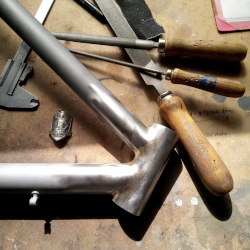Steel Frames
Steel is the traditional material of choice in frame construction. Until a few decades ago, most bicycles were made from this material, and for a good reason. Here are some of its main advantages:
Advantages:
- Durability and Strength: Steel is known for its ability to withstand wear over time. A well-maintained steel frame can last for decades. Its resistance to fatigue makes it ideal for those looking for a bike to use for years without worrying too much about structural damage.
- Ride Comfort: Steel has a property called "damping" that allows it to absorb road vibrations. This results in a more comfortable ride, especially over long distances and rough surfaces.
- Repairability: Another great advantage of steel is its repairability. In the event of accidents or frame damage, steel can often be repaired with welding, which is not always possible with other materials like carbon.
- Classic Aesthetics: Steel offers a vintage and refined look that many cyclists appreciate. There is something unique about the clean design and thin lines of a steel frame. When custom-built, the aesthetics can be tailored to the customer's preferences by the artisan.
Disadvantages:
- Weight: Compared to modern materials like carbon, steel is heavier. This can be a limiting factor for cyclists who want to maximize performance on climbs or aim for an ultra-light bike. A good quality steel frame costs as much as a carbon one, but the carbon frame weighs about 500 to 600 grams less. Note that this does not prevent building a complete bike that weighs less than a carbon bike, depending on component choices. The lower weight limit to consider is 6.8kg overall.
- Corrosion: Although modern frames are often treated with anti-corrosion paints and coatings, steel is still susceptible to rust, especially in humid environments or where road salt is used. Regular maintenance is essential to prevent corrosion.
- Lower Stiffness: While comfortable, steel may not be the best choice for those seeking maximum stiffness and power transfer, qualities more commonly found in materials like carbon.
Carbon Frames
Carbon has become the preferred material for many professional cyclists and high-performance bike enthusiasts. Its popularity in recent years is due to its properties. Let’s see why.
Advantages:
- Lightweight: Carbon is known for its lightness. A carbon frame can be lighter than a steel one (but the difference nowadays is around 400 to 500 grams), making it ideal for those aiming for high performance, especially in races or steep climbs.
- Stiffness: Carbon offers superior stiffness, allowing for efficient power transfer from the cyclist to the bike. This results in faster accelerations and more responsive pedaling, qualities much appreciated by road cyclists. However, over long distances, this advantage can become a disadvantage due to the reduced comfort it brings.
- Aerodynamics: Thanks to carbon's malleability, designers can create complex aerodynamic shapes that reduce air resistance. This can make a difference, especially in competitions where every second counts. So, if you're competing where time differences are measured in tenths of a second, this could be crucial; otherwise, it might not matter as much.
- Tailored Properties: Carbon is a material that can be molded in various ways to achieve specific characteristics, such as greater stiffness in one area and more flexibility in another. This allows for highly advanced frame design.
Disadvantages:
- Cost: Carbon is generally more expensive than steel, both in terms of the material itself and the complexity of production. This makes it less accessible to those on a budget.
- Fragility: Despite its strength, carbon can be fragile in the event of severe impacts or accidents. Unlike steel, structural damage to carbon often requires frame replacement.
- Longevity: While a well-maintained carbon frame can last for years, it does not have the same longevity as steel. Carbon is subject to degradation from UV rays and general wear, which could affect its integrity over time.
- Complex Maintenance: Carbon frames require more careful and periodic maintenance, especially to detect invisible damage that could compromise rider safety.
- Limited Customizability: Carbon frames are often produced in preset sizes and numbers. Custom-built carbon frames can be complex and expensive, potentially negating many of the advantages listed above.
Which Should You Choose?
The choice between a steel and carbon frame largely depends on your specific needs and the type of cycling you do. If you value comfort, durability, and classic aesthetics, steel might be the right choice. On the other hand, if you're after high performance, lightness, and stiffness, and budget isn't an issue, carbon is probably the way to go.
Keep in mind that the frame's weight difference of 400-500 grams isn't decisive for the overall bike weight. The FCI and UCI set 6.8kg as the minimum allowed weight for a professional road bike, a goal more than achievable with a good steel frame.
As a "proof of concept," check out this steel road bike whose complete weight can be well below the minimum limit.
In conclusion, there is no "best" material overall. The key is to understand which material best suits your riding style and expectations. Both materials have their unique appeal and advantages, so the final choice is entirely yours.
Final Consideration
It's important to note that performance also depends on other factors, such as frame geometry, wheels, and even the cyclist's personal preferences.









 Every frame I craft is tailored to your unique needs and preferences, ensuring a perfect fit and unmatched performance
Every frame I craft is tailored to your unique needs and preferences, ensuring a perfect fit and unmatched performance